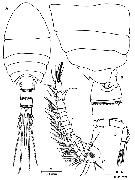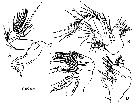|
|
 |
|
Calanoida ( Order ) |
|
|
|
Pseudocyclopoidea ( Superfamily ) |
|
|
|
Pseudocyclopidae ( Family ) |
|
|
|
Pseudocyclops ( Genus ) |
|
|
| |
Pseudocyclops constanzoi Baviera, Crescenti & Zagami, 2007 (F) | |
| | | | | | | Ref.: | | | Baviera, Crescenti & Zagami, 2007 (p.571, Descr.F, figs.F) |  Issued from : C. Baviera, N. Crescenti & G. Zagami in Crustaceana, 2007, 80 (5). [p.572, Fig. 1]. Female (from Faro lake, NE Sicily): A, habitus (dorsal); B, pedigerous somites 2-5 and genital double-simite (lateral); C, A1 (lateral); D, A2 endopod (lateral ) with exopod position indicated by arrow. Nota: - Prosome compact, oval in dorsal view. - Rostrum with large base, fused to cephalon, protruding ventrally. - A1 with 17 segments, armature element setae and aesthetascs as follow: 13 + 3a; 2; 2; 4; 2; 2; 2; 3; 2; 2; 2; 2; 2; 2; 4; 2; 5+ 2a. - Cephalosome and 1st pegiger somite separate, 4th and 5th pediger somites separate. - 2nd pediger somite with ventrolateral posterior corner produced into acute process. - 4th and 5th pediger somites with pointed epimeral margins dorsolaterally. - 5th pediger somite characterized by a tooth visible in lateral view. - Urosome 4-segmented. - Genital double-somite symmetrical, with gonopore and copulatory pore opening in common longitudinal slit on ventral side and with postero-ventral edge denticulate. - 2nd urosomal somite with denticulate edge around posterior margin. - 3rd urosomal somite with posterior hyaline frill and with distal margin denticulate; - Anal somite very small, without ornamentation, almost telescoped into 3rd somite. - Caudal ramus bearing 6 setae, sera II spiniform and seta V longest.
|
 Issued from : C. Baviera, N. Crescenti & G. Zagami in Crustaceana, 2007, 80 (5). [p.573, Fig. 2, A-D]. Female: A, Md (lateral); B, Mx1 (lateral); C, Mx2 (lateral); D, Mxp (lateral). Scale bar for all figures. Nota: - A2 biramous, coxa and basis clearly separate, both bearing 1 seta; endopod 3-segmented, 1st segment with 2 setae, 2nd segment with 8 setae, 3rd segment with 7 setae apically; exopod of both sides were lost. - Md with cutting edge of gnathobase bearing 7 cuspidate teeth; palp biramous, basis with 2 setae, endopod bearing 4 setae on 1st segment and 10 setae on distal margin of 2nd segment; exopod 4-segmented bearing 1, 1, 1, 3 setae, respectively. - Mx1 well developed; praecoxal arthrite bearing 9 strong spines and 5 submarginal slender serae; coxal endite with 3 setae; coxal epipodite with 6 setae; basis with 1 short seta (representing exite), 4 setae each on proximal and distal endites; endopod bearing a total of 16 setae; exopod bearing 11 setae along disto-lateral margin. - Mx2 with praecoxa proximal endite bearing 5 long setae and 1 rudimentary element, distal endite with 3 setae; both coxal endites with 3 setae. Basis and 1st endopodal segment fused to form allobasis, bearing 7 setae; endopod reduced, indistinctly segmented bearing 7 setae. - Mxp with syncoxa bearing 1, 2, 3 setae representing praecoxal and coxal endites; basis with 3 setae on proximal margin and 2 setae on distal margin, derived from incorporated 1st endopodal segment. Endopod 5-segmented, 1st and 2nd segments each bearing 4 setae; 3rd segment with 3 setae, 4th segment with 3 inner and 1 outer setae, 5th segment with 4 setae.
|
 Issued from : C. Baviera, N. Crescenti & G. Zagami in Crustaceana, 2007, 80 (5). [p.573, Fig. 2, E, F]. Female: E, P1 (anterior); F, P2 (anterioir). Scale bar for E and F.
|
 Issued from : C. Baviera, N. Crescenti & G. Zagami in Crustaceana, 2007, 80 (5). [p.575, Fig. 3]. Female: A, P3 (anterior); B, P4 (anterior); C, P5 (anterior). Nota: P5 with unarmed coxa; basis with an acute process on inner margin; exopod and endopod with 3 and 2 segments, respectively; 1st exopodal segment bearing 1 spine, 2nd segment with 1 spine and 1 seta, 3rd segment with 3 spines, a setiform spine and 2 setae; 1st endopodal segment with 1 plumose seta, 2nd segment bearing 2 distal plumose setae, located between 2 lateral processes and ornamented with 2 rows of spinules on the posterior side
|
 Issued from : C. Baviera, N. Crescenti & G. Zagami in Crustaceana, 2007, 80 (5). [p.574]. Female: Spine and setal formula of swimming legs P1 to P4. Spine : Roman numerals; setae: Arabic numerals.
| | | | | Compl. Ref.: | | | Belmonte, 2018 (p.273, Table I: Italian zones) | | | | NZ: | 1 | | |
|
Distribution map of Pseudocyclops constanzoi by geographical zones
|
| | | | | | | Loc: | | | W Medit. 38°16'N, 15°38'E (Faro Lake, Sicily) | | | | N: | 2 | | | | Lg.: | | | (972) F: 0,591; {F: 0,591} | | | | Rem.: | From wash water from specimens of Pinna nobilis.
For Baviera & al. (2007, p.574) , unique within the genus is the setation of the endopod of P5, with 1 seta on the 1st segment and 2 setae on the 2nd segment.
This species is most closely resembles P. umbraticus for the armature formula of the 3rd exopodal segment of P5 (I-0; I-1; III-I-2). P. umbraticus appears very similar to P. costanzoi also in the shape of the female P5, even if in P. umbraticus the female P5 endopod shows vestigial segmentation (Giesbrecht, 1893). | | | Last update : 06/02/2020 | |
|
|
 Any use of this site for a publication will be mentioned with the following reference : Any use of this site for a publication will be mentioned with the following reference :
Razouls C., Desreumaux N., Kouwenberg J. and de Bovée F., 2005-2025. - Biodiversity of Marine Planktonic Copepods (morphology, geographical distribution and biological data). Sorbonne University, CNRS. Available at http://copepodes.obs-banyuls.fr/en [Accessed October 13, 2025] © copyright 2005-2025 Sorbonne University, CNRS
|
|
 |
 |







